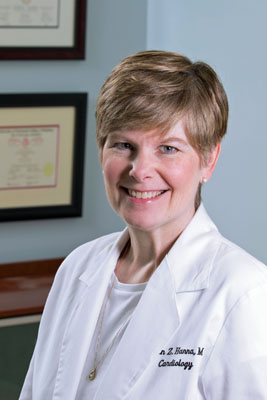Heart Of A Woman
With cardiovascular disease, women face unique challenges
Heart disease is the number one killer of women.
This is a difficult but crucial fact for women to understand when considering their primary health risks.

“To put this in perspective, about 1 in 29 women annually will die from breast cancer,” says cardiologist Karen Hanna, MD. “Whereas with heart disease, the number is 1 in about 2.4.”
Compounding the problem of
this formidable disease is how differently it can present itself in women as compared to men (heart disease is also men’s number one killer) and the challenges brought about by these differences in diagnosis and treatment.
Even
the risk factors for heart disease, which are the same for everyone, hold unique characteristics for women:
- Diabetes - A much more powerful predictor of heart disease development in women than in men, with cardiovascular mortality rates about 3 times higher for women than men with diabetes.
- Hypertension – In the elderly population, this is a stronger predictor of heart disease for women than for men.
- Tobacco use – Older but pre-menopausal women who are smokers, particularly those that take oral contraceptive agents, have a twentyfold increased risk of heart attack. “This is a combination of factors that leads to a high risk of heart attacks and strokes,” Dr. Hanna says.
- Cholesterol – Women typically have higher HDL’s (good portion of cholesterol) longer than men. However, Dr. Hanna warns that women need to understand that if their LDL (bad cholesterol) is high, they may still be at increased cardiovascular risk.
- Obesity – In the United States, adult women have a higher incidence of obesity than males.
Symptoms of cardiovascular disease typically manifest for women about ten years later, on the average, than their male counterparts. Women have a higher frequency of atypical presenting symptoms, such as fatigue, shortness of breath, and jaw
pain.
“Women may also experience more atypical-type chest pain,” Hanna says.
Sorting through these symptoms, which can be indicative of so many other conditions, is something that challenges physicians
every day.
“Unfortunately, these non-typical presentations can lead to a delay in diagnosis and appropriate treatment,” Hanna says. “The disease therefore tends to be more advanced when identified, and the mortality
rate is higher for women in the first year of diagnosis.”
Smaller-caliber coronary arteries in females (along with more advanced disease at diagnosis) partially explain why the mortality rate is higher for women during interventions
that are meant to revascularize—or restore adequate blood flow to—the heart, such as stents, balloons, and bypass grafting.
“The mortality rates for women and men who have had revascularization become similar about
a year following procedures,” Hanna says.
Some women may downplay their own symptoms because their first focus is their family’s wellbeing. Dr. Hanna hopes that women who see themselves as the caretakers will remember
to take care of themselves.
“Women really need to understand the importance of communicating any new symptoms they may have to their cardiologist or primary care physician,” Hanna says. “We are concerned with both
new patterns and progressive patterns of symptoms.”
Understanding their complete cholesterol profile through regular check-ups and keeping track of their blood pressure, even if they’re not on hypertension medication,
can help women—and their doctors—stay aware of their cardiovascular health and any potential risks.
“It’s helpful if you can track the trends of your blood pressure in a calm, resting state, which can’t
always be achieved in the doctor’s office,” Hanna says.